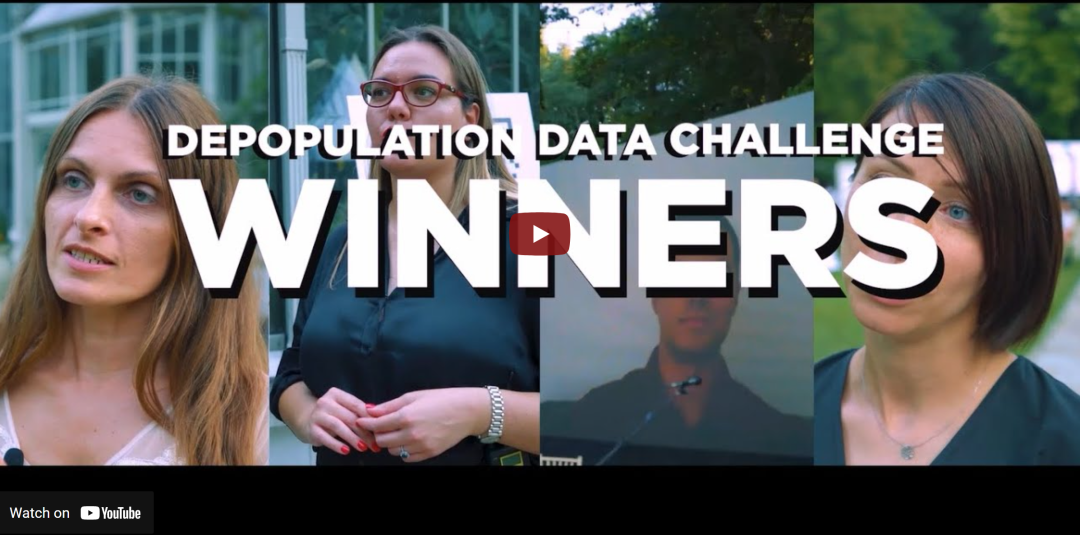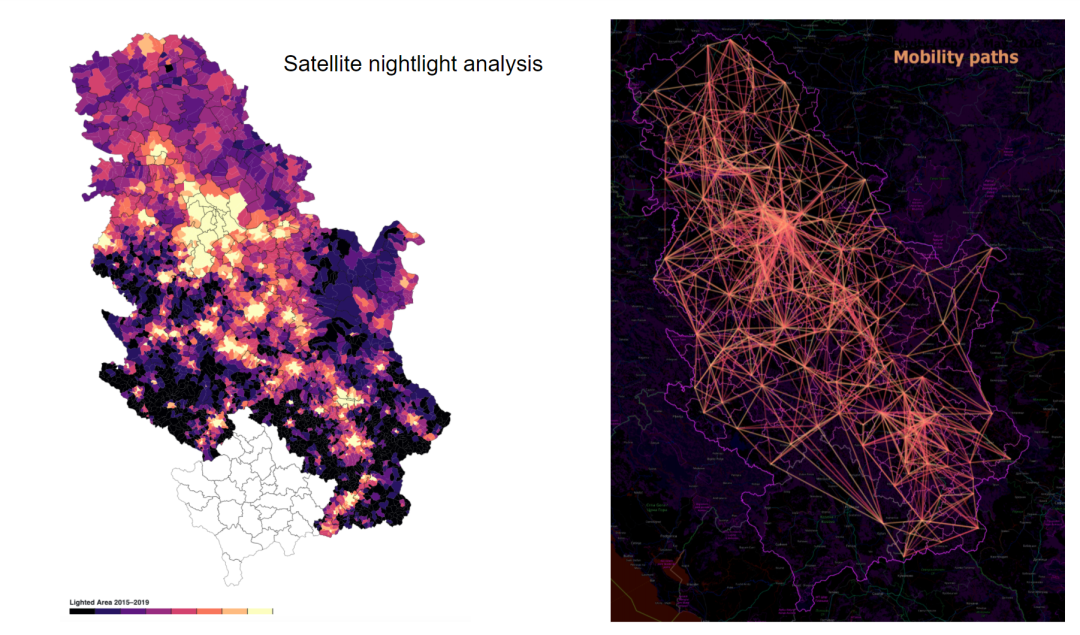Disclaimer:
Please be aware that the content herein has not been peer reviewed. It consists of personal reflections, insights, and learnings of the contributor(s). It may not be exhaustive, nor does it aim to be authoritative knowledge.
Overview
Prepared by (Name of the experimenter)
Kristina Jazinnka Nikolic
On date (Day/Month/Year)
2020, 2021
Current status of experimental activity
Completed
What portfolio does this activity correspond to? If any
Depopulation portfolio within UNDP Serbia CO
What is the frontier challenge does this activity responds to?
Depopulation in Serbia
What is the learning question(from your action learning plan) is this activity related to?
How might we use alternative data to better understand depopulation in Serbia?
Please categorize the type that best identifies this experimental activity:
Pre Experimental (trial and error, prototype, a/b testing)
Which sector are you partnering with for this activity? Please select all that apply
United Nations agency, Public Sector, Private Sector, Civil Society/ NGOs, Academia
Please list the names of partners mentioned in the previous question:
UNFPA, the Prime Minister's Office, Ministries, public institutions, BioSense Institute, Telecom Serbia Company, Infostud company, different organisations form the development, innovation and startup ecosystem, academia, etc.
Design
Hypothesis: IF... THEN....
H1. Data & IT community is willing to utilize its technical and analytical knowledge in order to help better understand the depopulation topic in Serbia. H2: The academic community and community of academic researchers are open to applying new methodologies (data sets and technology) to the depopulation problem in order to further their understanding of it. H3. Without the assistance of UNDP, the multidisciplinary teams needed to adequately address this challenge will naturally arise. H4. Offering incentives to interdisciplinary teams will greatly encourage them to participate in the challenge. H5. The precise results of the successful Data Challenge teams will be very helpful in understanding the subject of depopulation. Meetings and conversations with stakeholders from the data & IT community and academia helped to confirm the first two hypotheses. After teams presented their final project proposals, the third was confirmed, proving that almost all effective applicants had naturally established multidisciplinary teams. A follow-up interview with teams who applied verified the fourth hypothesis and the two final hypotheses. It's important to note that 50 teams submitted applications in the first round. This figure has surpassed even the most optimistic projections, which is remarkable given the complexity of the depopulation issue.
Does the activity use a control group for comparison?
No
How is the intervention assigned to different groups in your experiment?
Other
What is the learning intent of the activity?
UNDP Accelerator Lab strives to enhance collective intelligence and accelerate digital innovation by bringing together a diverse group of people, data, and technology. We think that by harnessing the unique strengths of each component and promoting collaboration, we can develop innovative solutions that outperform any single effort.
What is the object being tested?
Multidisciplinary teams teams working collaboratively to leverage their diverse skills, knowledge, and expertise in the design and development of data-driven/digital solutions to address Serbian depopulation.
What is the timeline of the experimental activity?
The experimental activity's timeline began with the initial idea and preparation phase, which occurred at the end of 2019. In 2020, the Challenge Call was launched, which called for data-driven/digital solutions to tackle depopulation in Serbia. The year 2021 saw the announcement of the winning solutions at a live event, marking the conclusion of the experimental activity.
Results
What were the key results?
The key findings and results of the Depopulation Data Challenge experiment are summarized in a blog post authored by Professor Vladimir Nikitovic and our Head of Exploration, Drasko Draskovic. The post discusses the potential of alternative data sources to shed new light on the issue of depopulation in Serbia. For more information on the insights and outcomes of the experiment, please visit: https://www.rs.undp.org/content/serbia/en/home/blog/2022/Kako_alternativni_podaci_mogu_da_bace_novo_svetlo_na_depopulaciju_u_Srbiji.html" target="_new" style="border: 0px solid rgb(217, 217, 227); box-sizing: border-box; --tw-border-spacing-x:0; --tw-border-spacing-y:0; --tw-translate-x:0; --tw-translate-y:0; --tw-rotate:0; --tw-skew-x:0; --tw-skew-y:0; --tw-scale-x:1; --tw-scale-y:1; --tw-pan-x: ; --tw-pan-y: ; --tw-pinch-zoom: ; --tw-scroll-snap-strictness:proximity; --tw-ordinal: ; --tw-slashed-zero: ; --tw-numeric-figure: ; --tw-numeric-spacing: ; --tw-numeric-fraction: ; --tw-ring-inset: ; --tw-ring-offset-width:0px; --tw-ring-offset-color:#fff; --tw-ring-color:rgba(59,130,246,0.5); --tw-ring-offset-shadow:0 0 transparent; --tw-ring-shadow:0 0 transparent; --tw-shadow:0 0 transparent; --tw-shadow-colored:0 0 transparent; --tw-blur: ; --tw-brightness: ; --tw-contrast: ; --tw-grayscale: ; --tw-hue-rotate: ; --tw-invert: ; --tw-saturate: ; --tw-sepia: ; --tw-drop-shadow: ; --tw-backdrop-blur: ; --tw-backdrop-brightness: ; --tw-backdrop-contrast: ; --tw-backdrop-grayscale: ; --tw-backdrop-hue-rotate: ; --tw-backdrop-invert: ; --tw-backdrop-opacity: ; --tw-backdrop-saturate: ; --tw-backdrop-sepia: ; color: var(--tw-prose-links); text-decoration-line: underline; text-underline-offset: 2px; font-family: Söhne, ui-sans-serif, system-ui, -apple-system, "Segoe UI", Roboto, Ubuntu, Cantarell, "Noto Sans", sans-serif, "Helvetica Neue", Arial, "Apple Color Emoji", "Segoe UI Emoji", "Segoe UI Symbol", "Noto Color Emoji"; white-space: pre-wrap; background-color: rgb(247, 247, 248);">https://www.rs.undp.org/content/serbia/en/home/blog/2022/Kako_alternativni_podaci_mogu_da_bace_novo_svetlo_na_depopulaciju_u_Srbiji.html."
What were the key insights of this experiment?
The key insights and findings from the Depopulation Data Challenge experiment are summarized in a blog post authored by Professor Vladimir Nikitovic and our Head of Exploration, Drasko Draskovic. The post discusses the potential of alternative data sources to shed new light on the issue of depopulation in Serbia. For more information, please visit https://www.rs.undp.org/content/serbia/en/home/blog/2022/Kako_alternativni_podaci_mogu_da_bace_novo_svetlo_na_depopulaciju_u_Srbiji.html" target="_new" style="border: 0px solid rgb(217, 217, 227); box-sizing: border-box; --tw-border-spacing-x:0; --tw-border-spacing-y:0; --tw-translate-x:0; --tw-translate-y:0; --tw-rotate:0; --tw-skew-x:0; --tw-skew-y:0; --tw-scale-x:1; --tw-scale-y:1; --tw-pan-x: ; --tw-pan-y: ; --tw-pinch-zoom: ; --tw-scroll-snap-strictness:proximity; --tw-ordinal: ; --tw-slashed-zero: ; --tw-numeric-figure: ; --tw-numeric-spacing: ; --tw-numeric-fraction: ; --tw-ring-inset: ; --tw-ring-offset-width:0px; --tw-ring-offset-color:#fff; --tw-ring-color:rgba(59,130,246,0.5); --tw-ring-offset-shadow:0 0 transparent; --tw-ring-shadow:0 0 transparent; --tw-shadow:0 0 transparent; --tw-shadow-colored:0 0 transparent; --tw-blur: ; --tw-brightness: ; --tw-contrast: ; --tw-grayscale: ; --tw-hue-rotate: ; --tw-invert: ; --tw-saturate: ; --tw-sepia: ; --tw-drop-shadow: ; --tw-backdrop-blur: ; --tw-backdrop-brightness: ; --tw-backdrop-contrast: ; --tw-backdrop-grayscale: ; --tw-backdrop-hue-rotate: ; --tw-backdrop-invert: ; --tw-backdrop-opacity: ; --tw-backdrop-saturate: ; --tw-backdrop-sepia: ; color: var(--tw-prose-links); text-decoration-line: underline; text-underline-offset: 2px; font-family: Söhne, ui-sans-serif, system-ui, -apple-system, "Segoe UI", Roboto, Ubuntu, Cantarell, "Noto Sans", sans-serif, "Helvetica Neue", Arial, "Apple Color Emoji", "Segoe UI Emoji", "Segoe UI Symbol", "Noto Color Emoji"; white-space: pre-wrap; background-color: rgb(247, 247, 248);">https://www.rs.undp.org/content/serbia/en/home/blog/2022/Kako_alternativni_podaci_mogu_da_bace_novo_svetlo_na_depopulaciju_u_Srbiji.html."
Context




 5Gender equality
5Gender equality 8Decent work and economic growth
8Decent work and economic growth 10Reduced innequalities
10Reduced innequalities 11Sustainable cities and communities
11Sustainable cities and communities 17Partnerships for the goals
17Partnerships for the goals
Comments
Log in to add a comment or reply.